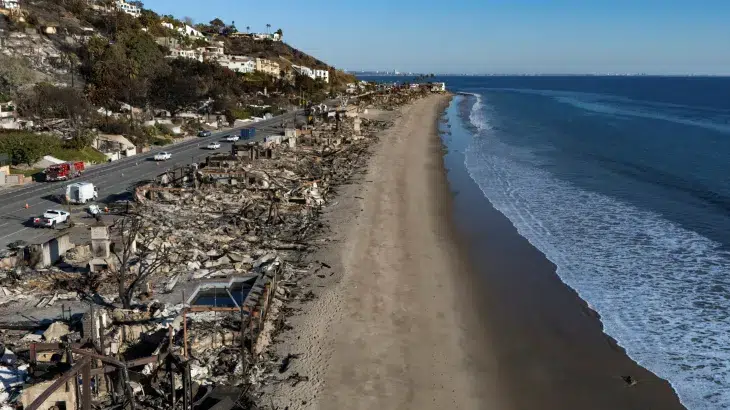LA wildfires: Is insurance the next battlefront for California residents? Leave a comment
As wildfires continue to ravage California’s Los Angeles County, attention is now turning to how tens of thousands of people directly affected by the devastation might recoup what they’ve lost – and a potential insurance storm that awaits them.
Thousands of properties have been damaged or destroyed and owners are uncertain whether insurance will cover for them. The ongoing fires could become the most expensive in terms of insured losses in California history, with analysts estimating that losses could approach $20bn.
Here’s what you need to know.
How much damage have the wildfires caused so far?
At least 27 people have been killed in the wildfires.
The wildfires, the first of which broke out in the Pacific Palisades, have engulfed 9,596 hectares (23,713 acres) of land, according to the California Department of Forestry and Fire Protection (Cal Fire). More than 12,300 homes and structures have been destroyed.
Two fires are active in Los Angeles County: Palisades, with 27 percent containment, and Eaton, with 55 percent containment.
How costly are the LA fires?
Analysts project based on preliminary estimates that the LA wildfires could be the costliest wildfire event in California, in terms of insured losses, possibly exceeding $20bn. An insured loss is the financial damage caused by an event that is covered by insurance.
Private forecaster AccuWeather estimates total damage and economic loss between $250bn and $275bn, which would make the LA fires the costliest natural disaster in US history, surpassing Hurricane Katrina in 2005.
So far, the costliest wildfire in terms of insured losses was the 2018 Camp Fire in Northern California’s Butte County, with losses adding up to $12.76bn.
Historically, some of the costliest natural disasters in terms of insured losses have been hurricanes in the US, and earthquakes. The insured losses from Hurricane Katrina totalled $105bn.
What did insurance companies do in the lead-up to the wildfires?
Before the fires broke out, insurance groups such as State Farm and Allstate started cancelling home insurance policies in areas prone to fires.
As of 2022, the Illinois-based State Farm was California’s largest insurer.
In July 2024, it dropped about 1,600 policies for homeowners in Pacific Palisades, which meant 69.4 percent of its insurance policies in the county were not renewed.
Between 2020 and 2022, insurers did not renew 2.8 million homeowner policies in California. More than half a million of these were in Los Angeles, according to the California Department of Insurance.
“There’s been a mass exodus of big players from the market in these parts of California,” Ben Keys, a real estate and finance professor at the Wharton School of the University of Pennsylvania, told a conference on Friday.
“We’ve seen enormous non-renewals recently,” he said.
David Flandro, the head of industry analysis and strategic advisory at Howden Re, a global reinsurance broker, says the size of the wildfire and scope of the damage could be cause for concern.
“Maybe there isn’t the coverage in place, to cover everyone unfortunately,” he told Al Jazeera.
Why did State Farm cancel insurance?
In May 2023, State Farm released a statement that it would stop accepting new applications, including business and personal lines property and casualty insurance. The statement added that this was due to “historic increases in construction costs outpacing inflation, rapidly growing catastrophe exposure, and a challenging reinsurance market”.
Brooklyn-based reporter Jake Bittle told the PBS network that State Farm and other insurers dropped or limited policies in California because “the state of California had limited the amount that insurance companies could charge to their customers.”
In 1988, California passed a ballot measure in its general election called Proposition 103 or the Insurance Rate Reduction and Reform Act.
The proposition rolled back insurance rates and established a prior approval system where an insurer has to get the California Insurance Commissioner’s approval before implementing property and casualty insurance rates.
However, these approvals take time. California’s system has been slow and is getting slower. It took 157 days on average, between submission and resolution of rate filings for homeowners’ insurance, between 2013 and 2019. This increased to 293 days on average between 2020 and 2022.
California’s law also decrees that insurers must justify their rates for catastrophe-related losses based on average losses from that catastrophe over the past 20 years.
For the California wildfires, future projections based on past losses would be inaccurate because the fires are unpredictable, getting more destructive than they were in the past, insurers have argued.
Between 2004 and 2013, wildfires in California destroyed about 653 structures on average, annually. Between 2014 and 2023, however, wildfires in California destroyed about 5,669 structures on average each year. This average was pulled up by destructive fires in 2017, 2018 and 2020.
In 2017, the Thomas Fire razed 1,060 structures in California’s Ventura and Santa Barbara. In July 2018, the Mendocino Complex Fire destroyed 280 structures in Mendocino, Lake, Colusa and Glenn counties, and in November 2018, the Camp Fire destroyed almost 19,000 buildings in Northern California’s Butte County.
Proposition 103 “contributed to the challenges” faced in the California insurance market, Ray Lehmann, senior fellow at independent research organisation, International Center for Law and Economics, told Al Jazeera.
Lehmann said the most notable of these challenges is that the proposition has “historically not permitted insurers to consider the cost of reinsurance or the output of forward-looking catastrophe models when filing rates”.
“This effectively means that the state does not permit insurers to consider the impact of climate change, or that future losses may be much more significant than past losses.”
Amid this ravage, insurance companies “lost decades of underwriting profits” and “became convinced that they couldn’t make money or enough money doing business in California”, Bittle told PBS. He explained that this also contributed to the companies pulling out of California.
What have homeowners done about this?
Some homeowners have opted for the insurance programme set up by the state called The California FAIR Plan (Fair Access to Insurance Requirements), which was established in 1968 to cover people who could not obtain standard home insurance for various reasons.
The FAIR Plan is funded by private companies, not taxpayer money, and was originally conceived to hand out a limited number of policies to people who did not have standard insurance. As of 2024, 452,000 people in California have the FAIR Plan. However, the plan only offers basic coverage, up to $3m, which might not be enough for complete rebuilding of some houses.
As of July 2023, there are nearly 15 million housing units in California and as of July 2024, the population in California is nearly 40 million, according to the US Census Bureau website.
The FAIR Plan is also more expensive than standard insurance. A December 2024 note by New York-based financial services company Bankrate says in California, the average annual cost of a FAIR Plan policy was about $3,200.
In comparison, the average house insurance costs $1,480 in California for a $300,000-dwelling policy, according to Bankrate.
The result: Hundreds of thousands of homeowners do not have property insurance in California.
A report published on January 9 by online marketplace LendingTree estimated that 806,651 homes in California are uninsured, of the 7.6 million homes in the state. In Los Angeles, 154,108 homes are uninsured out of the 1.5 million homes, meaning 1 in 10 homes are uninsured in the county, LendingTree estimated.
Still, as a result of private insurers pulling out of California, “the state’s insurer of last resort FAIR Plan has grown exponentially,” Lehmann said.
Indeed, as private insurers withdrew, the exposure of the FAIR Plan grew dramatically, up 61.3 percent between September 2023 to $458bn in September 2024. FAIR has $5.9bn of exposure to the Pacific Palisades.
Is the climate crisis an insurance crisis?
Wildfires are among environmental disasters that intensify as a changing climate looms over the planet.
A report by the US Environmental Protection Agency (EPA) says climate change has contributed to an increase in the frequency, season length and burned area of wildfires. While wildfires in California were previously limited to a span of a specific few months, the state’s Governor Gavin Newsom recently spoke of how there is no longer a fire “season” in California.
“It’s year-round in the state of California,” Newsom said in a video posted to his X account on January 8.
Research suggests the insurance world is not adequately ready to pay the price of the climate crisis.
In 2024, a report from campaign group Insure Our Future found that climate change is the reason for a third of weather-related insurance losses worldwide over the past 20 years.
“The California Department of Insurance has taken some steps in the right direction by promulgating new rules to permit consideration of catastrophe models and the cost of reinsurance for those insurers who agree to write a significant amount of business in wildfire-exposed areas,” Lehmann said.
He added that “to ensure that California remains insurable into the future”, state leaders need to consider significantly investing in mitigating wildfires. This could mean “changes to the building codes, permitting utilities to invest in underground transmission lines, or rethinking land use planning and zoning in the wildland-urban interface.”
Will companies be able to cover insured losses?
Despite the high cost of the damage, experts believe insurance companies should have no problem compensating their customers.
“By and large, insurers writing homeowners insurance in California are financially strong and should not face any serious concerns about solvency,” Lehmann said.
According to a Standard and Poor’s report, insurers are starting 2025 with comfortable reserves thanks to strong financial results over the last two years.
Analysts at JPMorgan have argued that, as things stand, they expect “the vast majority of losses stemming from the wildfires to be concentrated in homeowners’ insurance”, and a “significantly lesser amount” in commercial losses and personal auto.
However, Lehmann added that “the Palisades Fire did disproportionately affect very costly properties, many of whom are likely to have coverage via High Net Worth.”
- If you are looking to order local products, handcraft, custom clothes, various books, handmade arts, furniture’s, food spices etc. please, visit our web page at www.ethio-amazon.com. Or send us your request at email contact@ethio-amazon.com you can also contact us on WhatsApp at +2519-44-36-97-53
Additionally, if you would be interested to socialize and looking for a new friend around the world, for future partnership… visit our web page at www.contactyourlifepartner.com
We believed that love can happen anytime, anywhere in a world filled with endless possibilities… for more information contact us at Email contact@ethio-amazon.com or Call us at +2519-44-36-97-53 (WhatsApp),
+ 6676539901 (international)Source (Al jazeera News)

